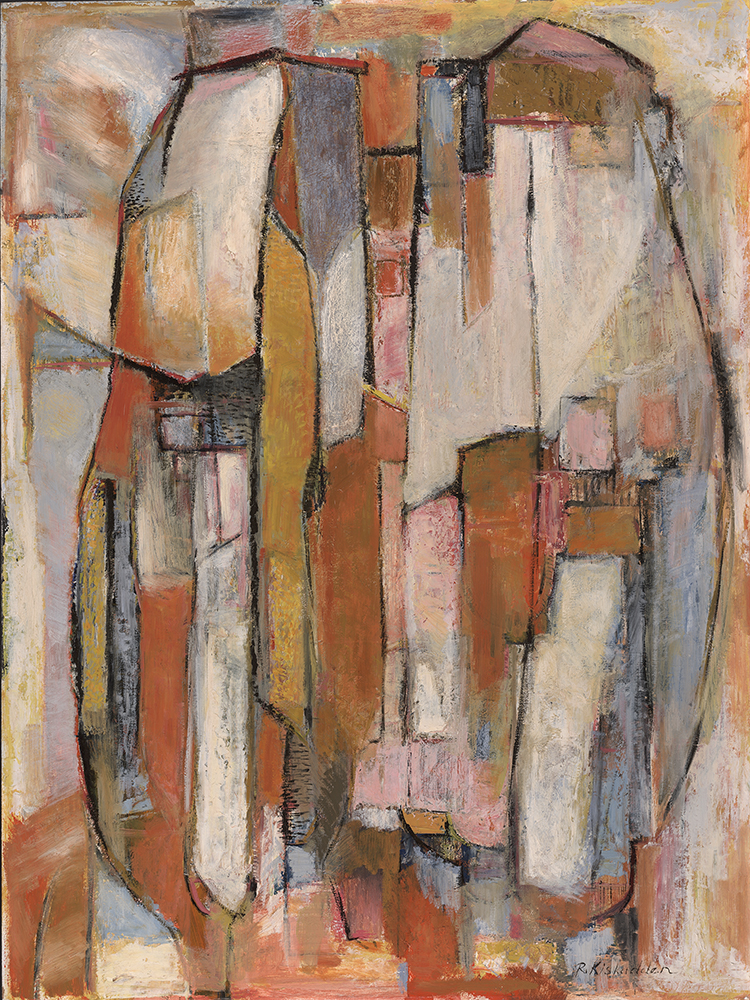
Italian Facade
Kiskadden, Robert M.
about 1956
Artwork Information
-
Title:
Italian Facade
-
Artist:
Kiskadden, Robert M.
-
Artist Bio:
American,1918–2004
-
Date:
about 1956
-
Medium:
Oil on Masonite
-
Dimensions:
40 x 30 inches
-
Credit Line:
Wichita Art Museum, Museum purchase, Third Air Capital Annual 1956 Purchase Award
-
Object Number:
1956.7
-
Display:
Not Currently on Display
About the Artwork
Robert Kiskadden’s painting Italian Façade exemplifies the “middle way” of modernist painting in American art of the 1950s, a hybrid style that acknowledged abstract expressionism’s priority of tactility and agitation in the over-all paint surface while adhering to the structural armature of geometry implicit in Cézanne and cubism. Kiskadden employed individual cubic strokes of color to build an illusory low-relief suggestion of an architectural façade. Juxtaposed patches of varied hues and tints evoke the idea of details such as windows, doorways, and multiple elements of architectural ornament. The artist stabilized his blocks of color and emphasized the vertical thrust of his subject with the use of think black lines to outline tall oblong ribbons of color—ribbons that may also be read as the angled facets of a building or complex of buildings.
Kiskadden balanced this concern for structure with a strong appeal to sensation in the tactile impasto skin of the paint and the delicious warmth of the orange-yellow color palette.
Robert Kiskadden exerted considerable influence upon the development of Kansas painters through his thirty-five year tenure (1949–84) as a professor of painting and drawing, and as Assistant Dean of Fine Arts at Wichita State University, Wichita, Kansas. He was admired by students and fellow artists for his exceptional craftsmanship as well as for his sensitive drawing skills and painterly ease in both watercolor and oil media. In the latter part of his career he devoted his art to expressionistic interpretations of the western landscape.
The holding of the Robert Kiskadden painting Italian Façade in the Wichita Art Museum collection not only documents the leading aesthetic taste of academe in 1950s America, but also a formative period in the administrative history of the Wichita Art Museum. From 1951 to 1955 the city of Wichita contracted with Wichita University’s Fine Arts Department to administer the affairs of the museum. Dr. Eugene S. McFarland, then head of the university’s art and design program, served as museum director and he engaged Kiskadden and other Wichita University faculty to perform curatorial duties: they organized loan exhibitions, inventoried the collection, and physically installed the exhibitions. McFarland, supported by a twenty-five member advisory committee appointed by the city, instituted an annual competition for Kansas painters that operated from 1954 through 1973 first under the title Air Capital Annual and later, Kansas Artists Annual. This competition encouraged professionalism in regional arts and brought a number of works by local and regional artists into the collection via purchase awards.